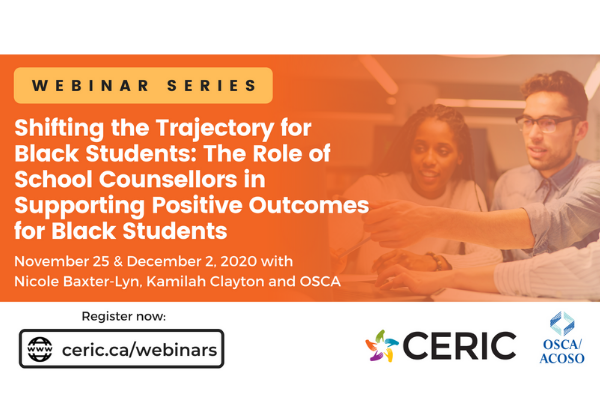
New webinar series to help school counsellors support Black students
November 2, 2020
Graduate students win award to attend virtual Cannexus21 conference
November 19, 2020A new CERIC-funded study has found evidence to support that career education in high school changes students’ career choices and pathways. The research by Social Research and Demonstration Corporation (SRDC) uncovered that career interventions particularly help lower-income students in clarifying their career plans. The research project, “Role of career education on students’ education choices and post-secondary outcomes” aims to understand when, where and how youth initiate and craft their career aspirations.
The report generates new evidence from unique Canadian data to support decisions of policymakers and practitioners on a) how and when to intervene to assist youth in their career decision-making, and b) for whom supports are effective yet currently lacking. This builds on an earlier literature review from SRDC published this spring. Overall, the analysis equips the career counselling profession to respond authoritatively to increasingly urgent policy questions about how optimally to structure career education for young people.
In the research, SRDC uses two rich longitudinal data sources to test career interventions through the linkage of education records to surveys of youth and parents in three provinces. The data document the lives of 7,000 young Canadians over 10 years, including their occupational aspirations as high school students at age 14, their post-secondary education and their employment outcomes. The interventions tested very different types of prompts to youth that might influence their careers.
From the Future to Discover project:
- Learning Account (LA) – A promise made at the end of Grade 9 of an $8,000 grant automatically payable upon enrolment in post-secondary education over two years
- Explore Your Horizons (EYH) – These expert-designed career education workshops support participants in preparing for career development through a carefully constructed developmental sequence of classroom-based activities
- LA+EYH – Encourages engagement and preparation with more certainty around the availability of financial aid, by combining the supports in the above two interventions
From the BC Advancement Via Individual Determination (BC AVID) project:
- BC AVID – Promotes and supports academic engagement with specially trained educators and counsellors intended to change the high school experience of students with as-yet-untapped potential to succeed in post-secondary education
The literature review established youth are often in their career exploration stage until age 20. It follows that youth can have low clarity on their career aspirations as well as less information or knowledge about the program requirements, which hinders matching their career aspirations to a program of study. Because the interventions provided additional support or focus (or both) to prepare or engage youth in their career development, students could be helped by them in clarifying and realizing their career interests. The analysis was designed to detect 1) what intervention made a difference and 2) to whom, in either switching from their initially unclear career aspirations to a clearer career plan OR maintaining their career aspirations and being able to identify the steps they need to realize their aspirations at an early stage. At this point, the researchers did not assign a positive or negative value to the changes observed.
The report draws the following broad conclusions:
- The LA early guarantee of a post-secondary grant and EYH offer of career education workshops appeared to directly impact lower-income students, switching them away from their early career aspirations. BC AVID had similar impacts.
- There is evidence that the effect of EYH workshops for students from higher-income families was more often indirect, inducing them to increase volunteering activities. Among this group, more tended to change career paths as an effect of the volunteering.
- Career education typically increased the number of other career-related activities students engaged in, which appeared in turn to delay some disinterested students from entering the labour market via easy-to-obtain jobs straight after high school.
- Having a LA increased participation in career activities, academic engagement, parental valuation of post-secondary education and volunteering for students from lower-income families, pointing to the importance of addressing the financial barriers to further education.
- Notably, the interventions decreased the likelihood that students from lower-income households carried out their early career aspirations, suggesting that career programming is effective at changing the focus and choices of youth with more disadvantaged backgrounds.
The study also found evidence of career teachers/counsellors, parents and peers influencing the impacts of career education.
What was apparent from the research is that there are differences in career pathway decisions between socioeconomic groups. Students with a lower socioeconomic status start with less clarity in career aspirations or less often have firm career plans than their counterparts from families with higher socioeconomic status. Career education interventions seem disproportionately to help those without post-secondary-educated parents and from lower-income families clarify their career plans (and thereby result in more changes for these youth to their intended program of study at Grade 12 relative to their intent at Grade 8/9).
According to the report authors, led by Research Director Reuben Ford, while this large set of findings sheds important light on a poorly understood yet key stage of youth career decision-making, much more needs to be done. They will be seeking to apply the research approach to consider how career education affects outcomes beyond career choices, to:
- improve life chances of the youth involved (health, well-being, earnings);
- improve the functioning of the labour market or economy, including minimizing disruption in future, adult career transitions; and
- reduce the time spent out of work or NEET, underemployed or in occupations where their skills are misaligned with the tasks they must perform.
The authors state that “Career decision making is, by definition, a long-term endeavour of critical importance to the life chances of individuals and the functioning of economies.” Therefore, they recommend further investment in data that can help youth, those who advise and support them and policymakers, understand the consequences of those decisions and the environments that support optimal outcomes. They also flag that there is a need to consider gender, language and racialized dimensions of career decision-making. Additionally, they highlight the need to project the results onto the labour market and educational realities of the 2020s, to ensure further recommendations are relevant to an era transformed by the consequences of the COVID-19 pandemic, automation and artificial intelligence, other influences on labour market precarity, new online learning as well as diversity and inclusion.
You can learn more about the findings in a free CERIC webinar on “What Influences High School Career Decision-Making” with the project leaders on November 23. Project leaders will also host a Learning Lab on January 27 as part of the virtual Cannexus conference where participants can explore the research in-depth.

